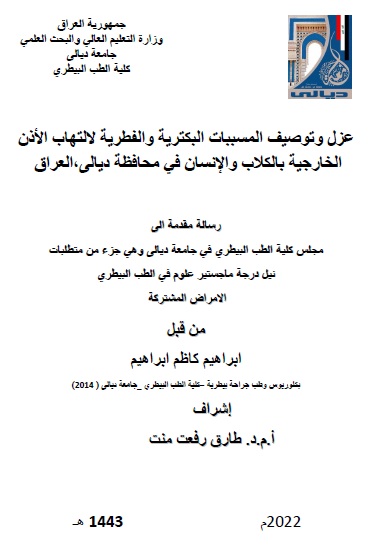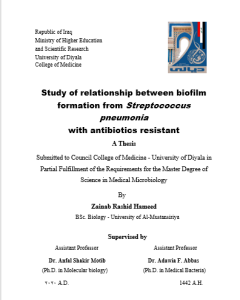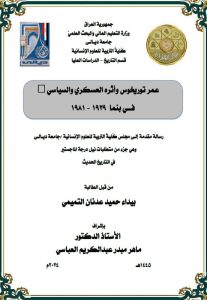اعلام المكتبة المركزية / المهندس مهند
Summary
Otitis externa is the most common disease of the ear canal in the dog and human with a multifactorial etiology, which includes bacteria, fungi, yeasts and ectoparasites. The study was conducted on (250) samples, represented (100) ear swabs collected from peoples, (50) from males and (50) swabs obtained from females, while (150) samples obtained from dogs (75) from males and (75) swabs collected from females. Samples collected from different places in Diyala Province, during the period from beging of 2020 the of 2021. Identification of isolates were depended on the morphology of the colony on agar used in the study (color and shape) in addition to their odor, and biochemical tests then conducted by VITEK 2 to identify the isolated bacterial and fungal species.
Clinically,skin scraping Scaly debris, discharge, ear wax, stenosed canal tragal tenderness, hyperaemic/edematous ear canal finding were recorded in patients with Otitis externa. While, erythema, dermatitis, loss of hair, crust hyperkeratinazion, lichenification of the ear epithelium; Increase of ceremonious with waxy material in ear and drooling of ear in some cases. On the other hand, Shaking of head, excessive scratching, hematoma, painful at palpated ear infected, itching in dogs Otitis externa.
Regarding to the patients and dogs gender, it was found that males had a tendency to get infection more than females when ( 98.7%) of dogs were males and (96 %) females. Moreover, the old age groups were most subjected to the infection of Otitis externa than other age group in dogs and patients.
Rsults showed hingh percent of bacterial spp (76%), while from dogs (90%). The results referred that the samples from human and dogs showed the bacterial isolates rate was Staphylococcus spp. 59/222 (26.6%) followed by Pseudomonas spp. 45/222 (20.3%), Proteus spp. 29/222 (13.1%), E. coli 26/222 (11.7%), Streptococcus spp. 25/222 (11.3%), and Klebsiella spp. 18/222 (8.1%), Pasteurella spp. 8/222 (3.6%), Corynebacterium 7/222 (3.2%) and Enterobacter spp. 5/222 (2.3 %).
In particular, from human samples, the highest isolates were Staphylococcus spp (26.3%), followed by Pseudomonas spp.
(21%), Proteus spp. (17%), E. coli (14.5%), Streptococcus spp.10/76 (13%), Klebsiella spp.7/76 (9.2%) and Corynebacterium (1.3%). While, from dogs samples, the highest one was Staphylococcus spp.39/135 (26.7%), followed by Pseudomonas spp. 29/135 (19.9%), Proteus spp. 16/135 (10.9%), Streptococcus spp. and E. coli each 15/135 (10.3%), Klebsiella spp. 11/135 (7.5 %), Pasturella spp. 8/135 (5.5%), corynebacterium 6/135 (4.1%) and Enterobacter 5/135 (3.4%) with significant differences p≤ 0.05.
On the other hand, the results referred that samples from human and dogs showed the highest fungal infection was Candida spp. 43/114 (37.7 %) followed by Malassezia spp. 35/114 (30.7 %), Aspergillums spp. 25/114 (21.9 %) and Trichophyton 11/114 (9.7 %) significant differences p≤ 0.05 between fungal isolates in dogs and human.
Antibiotic susceptibility of bacterial isolates against (10) of commonly used antibiotic was determined through disc-diffusion method. Results declared that, generally, all isolates were sensitive to Gentamycin; Ciprofloxacin; Tetracycline and Amikacin. While all isolates were resistant to Azithromycin ; Chloramphenicol and Ampicillin.
Genomic DNA was isolated from bacterial growth and universal primers were utilized to confirm the isolates. DNA was extracted from Staphylococcus aureus, Pseudomonus aeruginosa isolates and E.coli. Results showed that the recorded range of DNA concentrations were 36-97 ng/μl, 65-70 ng/μl, 34-50 respectively and the DNA purity was (1.5- 1.8).





